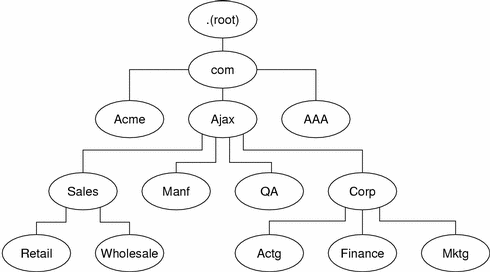| Lesson 5 | Zones |
| Objective | Define the Concept of Zones as used in the DNS Namespace |
Concept of Zones as used in the DNS Namespace
A branch of the DNS namespace under the administrative control of some entity is called a zone.
A company that registers the domain name company.com gains administrative control of the company.com zone.
However, it also gains administrative control of other zones. At the very least, it gains control of the in-addr.arpa zones corresponding to its network addresses. For example, suppose that company.com has two Class C network addresses (197.132.14.0 and 197.132.15.0). Then company.com will have control over the company.com zone, and the two reverse zones
14.132.197.in-addr.arpa and 15.132.197.in-addr.arpa.
The entire collection of DNS administrative domains throughout the world are organized in a hierarchy called the
DNS namespace. This section shows how the namespace organization affects both local domains and the Internet.
Like the UNIX file system, DNS domains are organized as a set of descending branches similar to the roots of a tree. Each branch is a domain, each subbranch is a subdomain. The terms domain and subdomain are relative. A given domain is a subdomain relative to those domains above it in the hierarchy, and a parent domain to the subdomains below it.
Like the UNIX file system, DNS domains are organized as a set of descending branches similar to the roots of a tree. Each branch is a domain, each subbranch is a subdomain. The terms domain and subdomain are relative. A given domain is a subdomain relative to those domains above it in the hierarchy, and a parent domain to the subdomains below it.
The concept of zones in the Domain Name System (DNS) namespace refers to a distinct administrative and logical partition of the DNS hierarchy. A zone represents a contiguous portion of the DNS namespace, containing all the resource records for a specific set of domain names and subdomains for which a single entity or organization is responsible. Zones enable efficient and distributed management of the DNS namespace by delegating authority and administrative tasks to different DNS servers and administrators.
A zone is managed by a primary DNS server, also known as the authoritative name server for that zone. The primary DNS server contains a zone file, which is a text-based configuration file that stores resource records for all the domain names and subdomains within the zone. Resource records define various DNS data types, such as A records (IPv4 addresses), AAAA records (IPv6 addresses), CNAME records (aliases), MX records (mail servers), and NS records (name servers).
DNS delegation is a key concept related to zones. Delegation allows a parent zone to transfer authority for a subdomain to a child zone, effectively creating a new administrative boundary. This is accomplished by adding NS records in the parent zone, pointing to the name servers responsible for the child zone. For example, the '.com' TLD zone can delegate authority for 'example.com' to a separate zone, managed by different name servers. The 'example.com' zone can then delegate subdomains, such as 'sub.example.com', to other zones in a similar manner, creating a hierarchical structure. Zone transfers are another important aspect of zone management. To ensure redundancy and fault tolerance, secondary DNS servers store copies of the zone data. Zone transfers (AXFR or IXFR) are the mechanisms used to synchronize zone data between the primary and secondary DNS servers, maintaining consistency across the DNS infrastructure.
Zones are a fundamental concept in the DNS namespace, representing logical and administrative partitions of the DNS hierarchy. They facilitate distributed management, delegation of authority, and efficient organization of the DNS namespace, contributing to the scalability, robustness, and reliability of the Domain Name System as a whole.
A zone is managed by a primary DNS server, also known as the authoritative name server for that zone. The primary DNS server contains a zone file, which is a text-based configuration file that stores resource records for all the domain names and subdomains within the zone. Resource records define various DNS data types, such as A records (IPv4 addresses), AAAA records (IPv6 addresses), CNAME records (aliases), MX records (mail servers), and NS records (name servers).
DNS delegation is a key concept related to zones. Delegation allows a parent zone to transfer authority for a subdomain to a child zone, effectively creating a new administrative boundary. This is accomplished by adding NS records in the parent zone, pointing to the name servers responsible for the child zone. For example, the '.com' TLD zone can delegate authority for 'example.com' to a separate zone, managed by different name servers. The 'example.com' zone can then delegate subdomains, such as 'sub.example.com', to other zones in a similar manner, creating a hierarchical structure. Zone transfers are another important aspect of zone management. To ensure redundancy and fault tolerance, secondary DNS servers store copies of the zone data. Zone transfers (AXFR or IXFR) are the mechanisms used to synchronize zone data between the primary and secondary DNS servers, maintaining consistency across the DNS infrastructure.
Zones are a fundamental concept in the DNS namespace, representing logical and administrative partitions of the DNS hierarchy. They facilitate distributed management, delegation of authority, and efficient organization of the DNS namespace, contributing to the scalability, robustness, and reliability of the Domain Name System as a whole.
Name Hierarchy
- Unique domain suffix is assigned by Internet Authority
- The domain administrator has complete control over the domain
- No limit on number of subdomains or number of levels
- computer.site.division.company.com
- computer.site.subdivision.division.company.com
- Domains within an organization do not have to be uniform in number of subdomains or levels Name space is not related to physical interconnection, for example, math.ohio-state and cis.ohio-state could be on the same floor or in different cities
- Geographical hierarchy is also allowed
- A name could be a subdomain or an individual object
Domains and Subdomains
